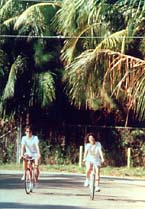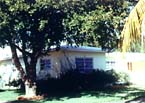
Nancy S. Masterson |
The threat of global warming has spurred concern over greenhouse gas emissions warming the climate. Scientists have been aware that city temperatures average two to fifteen degrees higher than the surrounding countryside. In the summer, this "urban heat island," created by expanses of concrete and pavement, costs up to $1 million per hour in excess cooling costs and contributes to global warming.
The First National Experiment:
Cool Communities
Cool Communities is a national, research and public education program of American Forests and the U.S. Dept. of Energy. It was established to motivate citizens and their governments to implement strategic tree planting and light-color surfacing to reduce energy consumption. Cool Communities educates about the energy savings resulting from these two low-cost strategies and monitors the resulting effects. |
| If all of us in the Sunshine State would plant trees for cooling shade and choose light color roofs, every community in Florida would be a little cooler. |
Cool Communities is the first large-scale demonstration of measuring the value of urban trees and light-colored surfaces in a public setting. It is one of the first studies of the benefits of these two strategies in real-life situations. In 1992, pilot cities of various climate zones were chosen to initiate the program, and Dade County was selected as one of the first seven cities to implement Cool Communities. Unlike previous laboratory or single-building tests, Cool
Communities used hundreds of private homes as experimental subjects. To optimize participation and acceptance, this required a grass-roots, participatory, and community involvement approach. |
|
Baseline Attitudinal Research (1993):
- People like trees for beauty and shade, but they are not aware of the energy savings.
- More people said they'd believe in a program if a non-profit organization ran it than the
utility or government agency.
- The overall reaction to Cool Communities was better than 90% favorable of all the cities tested, the highest scores were in Miami.
|
 |
The Experiment in Demonstration Neighborhoods
In 1994, a 20-member Dade County Advisory Committee selected model neighborhoods to
illustrate different tree and light surfacing conditions.
- Roof Color Lightening Site:
Downtown South Miami With funding from the Florida Advisory Council on Environmental Education, a contest was held among the building owners, vying for a free roof whitening. In November 1996, 3800 sq.feet of roof of Roberts Western Wear, a retail store in South Miami, was lightened with a donation of Ceramicoat made by Energy Efficient Roof Systems. In the first month after the roof coating, the electric bill dropped by $100 compared to the same month the previous year. A roof-top message is visible to 95,000 Metrorail riders every month.
- New Homes with All White Roofs and Strategically-planted Trees for Energy Conservation: Weitzer-Hammocks, West Kendall
In 1993, Weitzer Homes agreed to participate in Cool Communities by building a West Kendall
development with all white roofs instead of red tile. The use of light colors extends to window
treatments, doors and sidewalks. This site will be studied for electricity usage compared to
similar Kendall homes with darker colors.
Dade County conducted a modeling study of how trees were planted for aesthetics only, and then "rearranged" them so that they were planting strategically for energy conservation. For energy conservation, CITYgreen uses a relative rating system for trees in relation to how they were situated around a building. Trees that shade west walls, windows, and air conditioners were rated highest. In Weitzer-Hammock, energy savings for aesthetically planted trees were $70 compared to $217 for strategically placed trees.
- Existing Tree Canopy Site:
Residential South Miami
Residents assisted with an inventory of every tree in an eight square-block area. Its canopy cover, species, composition, and health were verified against digitized aerial photos.
- Increase Tree Canopy Site:
Richmond Heights
Initial funding from the Florida Division of Forestry for street trees introduced Cool Communities to this predominantly African-American community and built local expertise. For two years,
American Forests held "Walks for Trees" to raise private donations for trees. Then, with
funding from the Florida Advisory Council on Environmental Education, Block Captains were
recruited and trained in Cool Communities strategies. They led a grass-roots campaign to
enroll their neighbors in Cool Communities.
American Forests offered homeowners up to three free trees, if the homeowner agreed to specific locations for maximum energy conservation. In a five-square block area, two-thirds of the families accepted trees, and, for four weeks of the Cool Communities Plant-A-Thon, April 27-May 18, 1996, more than 540 volunteers planted 220 strategically sited trees to shade 85 homes. The homeowners provided refreshments in their yards for the volunteers, then lunch in the community center after each morning's planting. Every volunteer was given a tree, with care and energy-siting instructions, to take home and plant to shade their own home.
|
| Rays point the way. In Florida, three sides of your house recieve direct rays from the sun; east, west, and south. |
Upon Ecological Analysis (1996)
American Forests released a study of the value of Dade County's urban forest, funded by the Florida Division of Forestry. Dade's trees were found to save millions for County residents--$5.3 million per year in reduced air-conditioning costs and $4.8 million in removing carbon from the air. The urban canopy, covering 10% of Dade's surface, also reduces storm water run-off by 15%. The study also finds that the cooling shade of trees could be increased two and a half times--to $14.4 million per year--if every homeowner would plant just one more shade tree to shield the sun from their home. |
 |
Next Steps For Cool Communities
Demonstrations show others how they can apply the principles of Cool Communities to their
own homes. Public education grants will utilize the media and other distribution channels to
communicate the Cool Communities message.
- Energy-conserving landscaping starts with solar orientation to shade the east, west, and
southern exposures of homes. In Central and North Florida, a deciduous tree on the south will allow
winter sun to warm the house.
- Proper distance for small trees is 10'-16', large trees 16'-22' from walls, roofs, and windows. Trees should be close enough to shade walls but not too close to overhang roof. Another
function is to use shrubs to funnel wind flow to open windows when AC is off.
- Shade the external air-conditioning unit, but do not obstruct intake.
- Choose the right species by knowing the mature shape and eventual size.
- Add more canopy to lower temperatures in entire neighborhoods.
- Use light-colored surfacing and building materials.
|
|
The Future
- Florida Power & Light is evaluating the energy usage at the Cool Communities sites and
the Ecological Analysis sites in Dade and Broward. They have engaged Resource
Management International (RMI) to evaluate the effectiveness of strategic tree planting and
roof whitening over time.
- Lawrence Berkeley Laboratory, with support from the U.S. Dept. of Energy, is developing an SRI--Solar Reflectivity Index--to rate roofing and building products in reflectivity.
- Oak Ridge National Laboratory is conducting reflectivity and durability tests on roofing
products.
- The nation's Climate Change Action Plan has selected Cool Communities for expansion to
250 cities and 100 military bases. Cool Communities is now available as a training module for
cities to do community organizing and public education projects, combined with the CityGreen
evaluation software program so they can quantify their municipality's economic benefits of
urban trees in energy conservation, air quality improvement, and stormwater management.
|
|
In the future, we think natural resources will be included in traditional infrastructure planning. Cool Communities can help cities evaluate the significance of the urban forest on energy use and give value to this important natural resource in reducing energy demand and greenhouse gas emissions, and to sustain cleaner air and cooler, more sustainable cities in the future.
Nancy S. Masterson
|
|
You can contact Ms. Masterson at:
American Forests
Southeast Region Representative
33 S.W. Second Avenue, Miami, FL 33130
Tel. (305) 3724555
Fax (305) 372-6760 |


![]()
![]()




